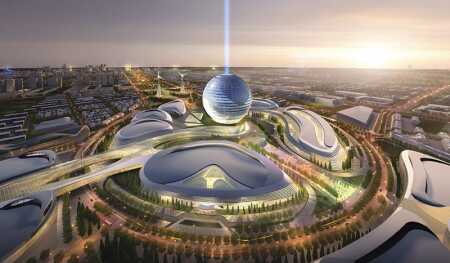International expositions, or World’s Fairs, have a history of leaving their mark on the landscape. The 1889 Expo in Paris bequeathed to the world the Eiffel Tower. The 1893 Chicago World Expo marked the debut of the Ferris wheel. And in 1962, the Seattle World’s Fair left that city the Space Needle as a memento.
Expo 2017, planned for Astana, Kazakhstan, may give the world an expo village that rates triple net zero—i.e., zero net use of energy and water and zero net generation of landfill waste. In late October, Adrian Smith + Gordon Gill Architecture (AS+GG) of Chicago announced that it had won the international design competition for the village. The theme for Expo 2017 is “Future Energy,” and the AS+GG design is intended to create the first “Third Industrial Revolution” city, in the words of the firm. “Energy consumed by the expo community will be provided from renewable sources. Buildings will become generators of power, and their energy will be stored using innovative technologies while being distributed by a smart grid. The expo community will provide infrastructure to encourage and support the use of vehicles that use renewable fuels,” says the firm’s announcement.
Adrian Smith, cofounder of AS+GG, says the firm’s work will include the overall site plan, exhibition halls, retail facilities, hotel space, a train station, parks, parking, and cultural facilities. There also will be 3,000 permanent housing units—“demonstration houses,” he says, in buildings three to six stories tall. (Smith, who is known for his work designing super-tall buildings, says his firm’s research has shown that the most efficient type of building is actually a three-story walkup, partly because such structures do not need elevators and other utility spaces.) Infrastructure built for the site’s cold, semi-arid climate will include a smart energy grid, a smart recycled water grid, an integrated waste management system, and interseasonal underground thermal energy storage.
The project will be developed in two parts. With the expo looming in June 2017, a fast-tracked design and construction process will produce exposition buildings, including the site’s centerpiece, the spherical, 258,000-square-foot (24,000 sq m) Kazakhstan Pavilion, which will have a transformative skin designed to reduce thermal loss and reduce interior solar glare. Integrated systems, including photovoltaics, will be used to increase the amount of—and save—energy produced by the buildings. The initial phase will also include hotel, retail, art, and performance spaces. The project’s second phase, following the expo, is intended to finalize the Third Industrial Revolution community. Expo buildings will be converted to form an office and research park, and the parking and service zones used during the event will be transformed into neighborhoods with an additional 700 residential units, plus office, hotel, market, and civic and educational facilities.
“The crucial difference of this project is that it is not a demonstration,” says AS+GG partner Robert Forest. “Expo 2017 will form the basis of a truly sustainable community that will serve as a legacy for Astana that will continue after the expo is finished.”





